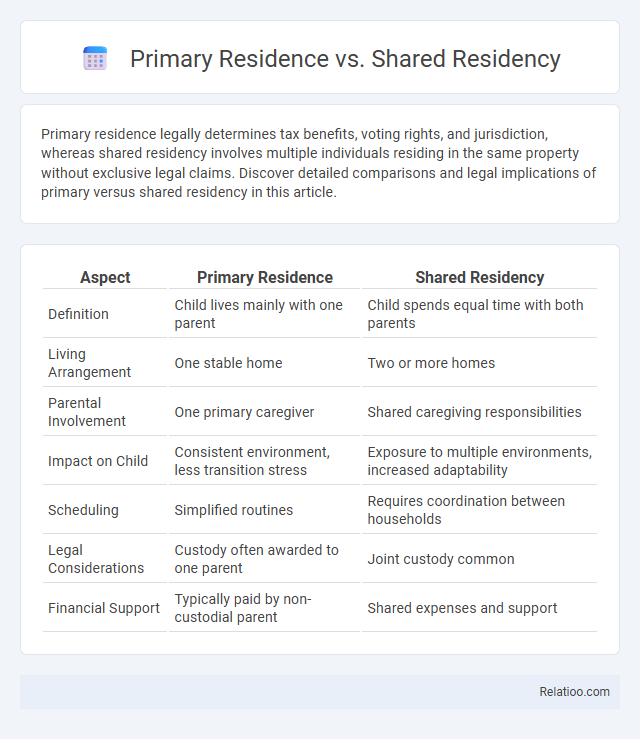Primary residence legally determines tax benefits, voting rights, and jurisdiction, whereas shared residency involves multiple individuals residing in the same property without exclusive legal claims. Discover detailed comparisons and legal implications of primary versus shared residency in this article.
Table of Comparison
| Aspect | Primary Residence | Shared Residency |
|---|---|---|
| Definition | Child lives mainly with one parent | Child spends equal time with both parents |
| Living Arrangement | One stable home | Two or more homes |
| Parental Involvement | One primary caregiver | Shared caregiving responsibilities |
| Impact on Child | Consistent environment, less transition stress | Exposure to multiple environments, increased adaptability |
| Scheduling | Simplified routines | Requires coordination between households |
| Legal Considerations | Custody often awarded to one parent | Joint custody common |
| Financial Support | Typically paid by non-custodial parent | Shared expenses and support |
Understanding Primary Residence and Shared Residency
Primary residence refers to the legal designation of where a child primarily lives, impacting custody arrangements and decision-making authority in family law. Shared residency involves both parents having approximately equal time and responsibilities for the child, promoting balanced involvement in daily life and long-term upbringing. Understanding these concepts is crucial for developing an effective parenting plan that reflects the child's best interests and parental collaboration.
Key Legal Definitions and Differences
Primary residence refers to the home where a child lives the majority of the time, often influencing custody decisions and legal responsibilities. Shared residency involves both parents having substantial and nearly equal parenting time, requiring clear agreements on decision-making and daily care. A parenting plan is a legally binding document outlining the specifics of custody, visitation schedules, and responsibilities to ensure clarity and prevent disputes; understanding these distinctions helps you protect your parental rights effectively.
Factors Influencing Court Decisions
Courts consider the child's best interests by evaluating factors such as emotional stability, the ability of each parent to provide care, and the child's relationship with each parent when determining primary residence versus shared residency. Parenting plans are scrutinized for their feasibility in maintaining consistent routines, promoting the child's welfare, and ensuring effective communication between parents. Evidence of each parent's involvement in the child's daily activities and willingness to cooperate often plays a crucial role in these custody decisions.
Parental Rights and Responsibilities
Primary residence determines where Your child lives most of the time, granting you significant decision-making authority regarding daily life and education. Shared residency balances living time between parents, ensuring both maintain legal rights and responsibilities, such as healthcare decisions and schooling. A parenting plan outlines specific parental rights and responsibilities, including visitation schedules, communication protocols, and conflict resolution methods to support the child's well-being.
Impact on Children’s Wellbeing
Primary residence provides children with stability and consistency in their daily routines, which is crucial for emotional security and academic performance. Shared residency allows children to maintain strong relationships with both parents, promoting balanced emotional support and reducing feelings of abandonment. Your choice between these arrangements in a parenting plan directly impacts your children's sense of safety, identity, and overall psychological wellbeing.
Financial and Tax Implications
Your choice between primary residence, shared residency, and a parenting plan significantly impacts financial responsibilities and tax benefits related to child custody. Establishing primary residence often allows one parent to claim tax exemptions, including dependent deductions and child tax credits, while shared residency may require coordination to divide these benefits. Financially, shared residency or detailed parenting plans demand clear agreements on expenses such as healthcare, education, and housing costs to optimize tax outcomes and minimize disputes.
Practical Considerations for Families
Understanding the distinctions between primary residence, shared residency, and a parenting plan is crucial for practical family arrangements post-separation. Your primary residence typically denotes where the child spends the majority of their time, while shared residency involves more balanced time allocations between both parents. A well-structured parenting plan outlines detailed schedules, responsibilities, and decision-making processes, ensuring clarity and minimizing conflicts for the child's stability and well-being.
Tips for Co-Parenting Success
Establishing clear communication and setting consistent boundaries are crucial for co-parenting success when navigating differences in primary residence, shared residency, or parenting plans. Detailed agreements outlining custody schedules, decision-making responsibilities, and child support obligations reduce conflicts and promote stability for children. Utilizing tools like shared calendars and mediation services ensures cooperation and prioritizes the child's well-being across all living arrangements.
Modifying Residency Arrangements
Modifying residency arrangements requires careful consideration of your child's best interests and may involve changes to primary residence, shared residency, or a specific parenting plan. Courts prioritize stability, consistency, and the child's emotional well-being when evaluating requests to alter existing residency agreements. Legal professionals often recommend thorough documentation and clear communication between parents to facilitate smooth transitions and avoid conflicts.
Common Challenges and Solutions
Primary residence disputes often arise from disagreements over where the child will live most of the time, leading to conflicts about stability and consistency. Shared residency arrangements can present challenges in coordinating schedules, communication, and ensuring both parents maintain equal involvement in the child's life. Parenting plans frequently require detailed agreements on decision-making, holidays, and conflict resolution to address common issues, with mediation and clear legal guidelines serving as effective solutions.

Infographic: Primary Residence vs Shared Residency
 relatioo.com
relatioo.com